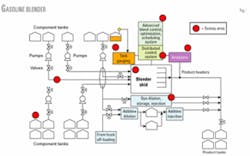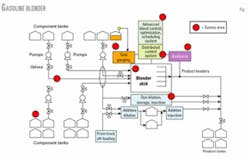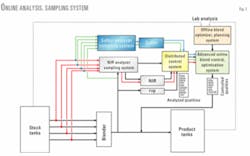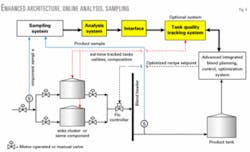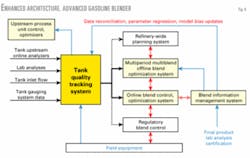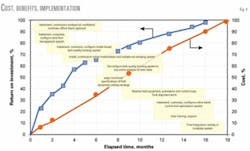Method outlines selection, design of advanced gasoline blending system
ADVANCED GASOLINE BLENDING— Conclusion
Refiners must recognize the required organizational changes and use an efficient and cost-effective system design when upgrading an existing blending system to an advanced one.
Part 1 of this series (OGJ, Feb. 14, 2005, p. 50) discussed the organizational changes required during an upgrade project that would lead to a sustained return on investment.
This conclusion of the series addresses the second component of an upgrade project—the hardware and software required, and how to design and select an efficient and cost-effective advanced blend control system.
Both articles are based on a study conducted in a midsized refinery in North America.
Refiners operate in a highly competitive environment. Many management teams understand the benefits that advanced blending control systems can provide; they want to install technologies that will give them a competitive advantage, including analyzers, distributed control systems, and advanced control software.
The problem is that refiners install expensive components with a low return on investment and ignore the relatively simple, yet efficient, components that would lead to a better return on investment.
This article identifies and discusses design considerations for the hardware, software, and interface components of an advanced gasoline blending control system; their relative cost-benefits analysis; overall system integration; and a strategy for phased system commissioning. We also present methods to benchmark a refiner's existing system using industry practices to estimate the investment required for an upgrade project.
Plant survey
Management of a midsize refinery contacted us to conduct a preliminary, 1-day plant survey to ascertain if it was economic to upgrade its current regulatory in-line gasoline blending control system to an advanced blend control system.
Our survey evaluated eight areas of the refiner's existing gasoline blending system (Fig. 1). We interviewed management, planner, blending engineers and operators, and analyzer and lab technicians. We examined the entire process from enterprise-wide planning to final blend execution and reconciliation.
We concluded that all areas of the refinery's gasoline blending control system were suboptimal and below the average industry standard. The refinery could save $6-8 million/year by upgrading to an advanced blending control system; this required an extensive master plan study to evaluate and design the architecture of blending system to capture the potential benefits.
A few months later, management contacted us to conduct this master plan study to assess the organization's capability and also prepare a blueprint for the architecture of a gasoline advanced blending control system.
Blending configurations
A refiner incorrectly assumes that, to capture all tangible benefits from a blending control system, it must invest in the best hardware and software. Management can wait for years for the approval of capital funds for this expensive blending project.
Most refiners can benefit from using low-cost components and an improved operating strategy. We based the study on that assumption.
Refiners adopt different blending configurations, which significantly affects how the blending control system is designed, configured, and implemented. These factors affect the blending system's design:
- Blending modes. Refiners can blend either directly from process units—usually referred to as "rundown blending," normally used for diesel and kerosine—or from tanks for gasoline products and crude oil. Some refiners also have tank-to-tank blending for diesel products.
- Types of blending. Tank-to-tank blending is either sequential—one tank at a time—or in-line where all components are blended simultaneously into one product tank. Although sequential blending is the least automated and loses some tangible benefits, it can still capture some of the tangible benefits by using strategic software like an off-line blend optimizer or a tank quality-tracking system.
- Source of blendstocks. Blending stocks originate from many sources such as stock tanks, process streams directly to the header, or process streams pooled to tank and then to the header. Each source affects the choice of hardware and software components for the blending control system.
We recommend avoiding the use of direct streams to headers and suggest using pooled streams to a tank for better control. In addition, if a refinery has at least two tanks for each stock type, we recommend using them in closed mode—with no input stream while blending—to achieve optimum blending with maximum benefits.
- Blend header interactions. Although multiple products blending using multiple headers is a common operation for rundown blending for diesel and kerosine, refiners in some countries use multiple headers to blend simultaneously leaded and unleaded gasoline. This requires a robust and comprehensive blending control system to avoid contamination when the same stream is shared for more than one blend header.
- Product destination. A refiner can blend product to a tank and then ship it later or blend directly to a pipeline or ship. For pipeline or ship blending, the on-line blend control software and online analyzer must be proven and robust for on-line certification because there is no opportunity to reblend.
*Dedicated control loops. We recommended highly the use of one dedicated control loop for each blendstock. The refinery in this study had more stock circuits than control loops and had an inefficient and time-consuming operation to line up control loops for stocks. As a result, the refiner lost blending flexibility and tangible benefits.
The refiner should also categorize the stocks carefully to differentiate them with respect to cost and qualities to better control and optimize the blend for maximum profitability.
Field equipment
Fig. 2 shows a typical example of the automation of blending field equipment. It includes a tank-gauging system, pumps, limit switches, motor-operated valves, and recirculation valves.
Other than the automatic tank-gauging system, automating the other elements does not add significantly to the tangible benefits. Automating other elements, however, may be useful for automatic lineups, minimizing human errors, safety, and fully automated blending operations.
Typically, automating field equipment represents 10-15% of the total benefits but with 30-40% of the total project cost. We advise revamping the field equipment only when a refiner upgrades from total manual to a fully automated advanced blending control system. Full automation, however, may not produce a justifiable return on investment for an existing in-line blender with partially automated field equipment.
Automatic tank gauging is required to monitor tank inventories for off-line -on-line blend control and optimization, custody transfer, inventory tracking, and refinery planning. The refiner should configure the system for all required signals such as level, temperature, density, pressure, and water level.
Analyzers, sampling system
On-line analyzers such as Cooperative Fuel Research (CFR) octane engines or multianalysis near infrared (NIR) analyze the qualities of the blend components or product header, which depend strongly on the blending configuration.
For example, if a refinery has tank-to-tank blending, two tanks, closed component, and no direct or wild stream configuration, online analyzers do not add any value. This is because the blend component qualities are static during blending and blend ratios do not change from initially optimized ratios that use lab analysis of blending tanks. But this is an uncommon blending configuration due to processes and economic constrains.
Fig. 3 shows a typical arrangement of on-line analyzers and lab analyses for gasoline blending using either CFR engines for product only or NIR analyzers for both components and products. The refinery in this study had only two sets each of research octane number (RON) and motor octane number (MON) CFR engines for product headers only; stock qualities were only analyzed in the lab.
The setup in Fig. 3 or the one at the refinery in this study is severely deficient due to the lack of timely availability of stock-tank quality analyses, lack of blend control for direct stream qualities, and the inability to adjust blend ratios to produce economically an on-spec final blend. This configuration results in 10-15% reblends and quality giveaways.
Refineries using on-line NIR analyzers (Fig. 3) have superior blending control and performance, except for off-line blend optimization. Refinery blend planners or blend optimizer engineers still depend on lab analyses of the stock and final products tanks before they can plan and optimize next blend. This is usually a bottleneck for the blend production schedule; it sometimes takes 8-12 hr before the lab analyzes and reports all tank samples.
Fig. 4 shows recent developments in advanced blending control technology. A tank tracking system uses nonlinear blending models to predict the qualities of all stock and products tanks nearly instantaneously. This architecture removes all the limitations of on-time availability of stock qualities and offers upstream unit feedback control and optimization. This system should save the average refiner about $1-1.5 million/year due to a decrease in the number of required lab samples and analyses.
Computer hardware
A typical PC based, client-server architecture is the basis for the advanced blend control system. It interfaces with a distributed control system (DCS) or programmable logic control-based system. The lowest blend regulatory control level resides in a DCS, which interfaces with all field equipment, on-line analyzers, controllers, tank-gauging system, and automatic tank-gauging computer.
We recommend advanced blend control system modules, which are independent of the DCS platform and not strictly connected with a specific DCS. This makes it easy to upgrade and take advantage of latest developments in blend technology.
Software
The software for an advanced blend control system can include some of all of these systems:
- Refinery planning and scheduling. Refinery planners use linear program-based tools to plan refinery supply, production, and dispatch schedules for a month. They download the information to different departments including the blend engineer who executes the plan.
The refiner may update the plan during execution if it has a feedback and reconciliation mechanism; otherwise it occurs at the month's end. This step also generates average blend recipes and blend product targets using average properties and production rates. The blend engineer can further optimize these recipes and targets.
- Off-line blend planning and optimization. The blend engineer starts with the monthly plan from the refinery planner, optimizes each blend individually 18-24 hr before its execution, and freezes its recipe for on-line execution. The blend engineer typically may plan many recipes at one time depending on refinery operational characteristics.
Refiners may use different tools for this step including the GRG2 optimizer solver in Excel, linear blend models and linear program optimizer, or more robust nonlinear blend models and nonlinear optimizers. Off-line blend optimization, if done correctly, achieves the maximum tangible benefits with or without on-line blend control. The benefits from this step are typically 40-45% of total return on investment with a noncapital investment that is less than 5% of total upgrade project cost. An additional investment in another system for on-line tank quality tracking can further increase this benefit by 10-15%.
One deficiency is the unavailability of current tank qualities for off-line optimization; the blend engineer has to wait 18-24 hr for lab analysis of tank samples, which an on-line tank quality-tracking system can minimize or eliminate eventually.
- On-line tank quality-tracking system. All refiners face the problem of the availability of current tank qualities. Lab analyses of tank samples can take 12-18 hr or longer, and the tank quality data may become outdated. The blend engineer is left with old data to optimize the blend recipe, which may result in an off-spec blend or one with a large quality giveaway.
On-line analyzers do not help this situation because they do not measure the tank's quality when it is not blending. A newly developed technology that strategically places on-line sampling points to predict the tanks' qualities in near real-time can save a refiner more than $1-1.5 million/year in lab analysis load and has increased overall benefits of blending control by $2-3 million/ year.
- Regulatory blend control. The first and mandatory level of blend control is known as blend-ratio control. It resides in the DCS for system upgrades from batch, or manual, to in-line blending. Refineries with less than 30,000 b/d of capacity can achieve this level of control cost-effectively by implementing a programmable logic controller-based system.
The blend ratio controls the amount of each component in the final product tank automatically and can potentially increase total product throughput by about 10-15%, which increases tangible benefits by about 5%.
This level of automation does not guarantee a product blended to specifications or an economically optimum recipe because it does not use any analyzer feedback. It does, however, relieve the operator from monitoring the process continuously.
It is also common in larger refineries that do not have advanced blend control. They use this level for "trim" control in which one component is designed to maximize one controlled quality in the final tank. Butane, for example, is used for the trim control of rvp, and alkylate or a similar component is used for the trim control of RON.
- On-line blend control and optimization. This optimizes blend ratios if there are quality changes in the component tanks or direct streams to the blend header. This level of control is necessary and beneficial for only these cases. If the blend configuration has two tanks for each component with a closed tank while blending, the qualities do not change during blending and ratios will remain constant, for all practical purposes.
Another reason for this level of control is to correct off-line optimized blend ratios that may be based on old qualities. An on-line tank quality-tracking system, however, will eliminate this problem because the blend engineer can optimize the recipe close to the blend execution schedule, or the blend operator can revise the initial recipe.
This control uses analyzer feedback, corrects the recipe frequently, and guarantees the final product on specifications. In addition to these software systems, blend reconciliation and model regression modules (Fig. 5) are also beneficial.
Cost, benefits, implementation
The refinery wanted to know where it stood with respect to other refiners regarding the advanced gasoline blend control system. There is no objective methodology to answer this question.
We attempted an estimate by categorizing all areas and subareas of the advanced blend control system and assigning them a degree of importance, or weighting factor, in the overall system upgrade strategy. We then reviewed each of these areas for the refinery and assigned it a percent-status level.
Combining these criteria and the refinery's state generated a benchmark index. We estimate this index to be accurate to ±10%. This index also indicated the level of investment to ±15% required to upgrade the existing gasoline blending facilities to an industry-standard advanced blend control and optimization system.
The benchmark index was around 40% of industry standard.
We found that 65-70% of tangible benefits from the upgrade result from investing only 10-15% of total project cost within 3-6 months of project initiation. The other 30-35% of the benefits accrue during the next 18 months by investing 80-85% of the project's cost.
Initial benefits are immediately visible and pay out during the project, whereas other benefits start only after the project is completed. Refinery management often treats this fact lightly; it waits for full capital project budget approval, which can take 2-3 years, before starting a project. It is much easier to execute a gasoline blending upgrade project in phases. Fig. 6 shows cost and return on investment for the different project phases.
The unique partnership of management and technical consulting allows companies to have a complete picture of what is required as well as associated costs and benefits of a blending project. We believe this integrated approach has great potential.
